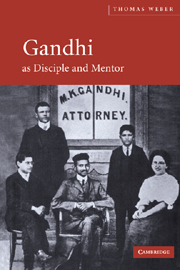Book contents
- Frontmatter
- Contents
- Notes
- Preface
- Glossary
- PART I INFLUENCE
- PART II GANDHI INFLUENCED
- 2 The influenced Gandhi
- 3 Henry Polak and the setting up of Phoenix Settlement
- 4 Hermann Kallenbach and the move to Tolstoy Farm
- 5 Maganlal Gandhi and the decision to leave Sabarmati
- 6 Jamnalal Bajaj and the move to Sevagram
- 7 The top of the hourglass: Gandhi influenced
- PART III GANDHI'S INFLUENCE
- Bibliography
- Index
3 - Henry Polak and the setting up of Phoenix Settlement
Published online by Cambridge University Press: 22 September 2009
- Frontmatter
- Contents
- Notes
- Preface
- Glossary
- PART I INFLUENCE
- PART II GANDHI INFLUENCED
- 2 The influenced Gandhi
- 3 Henry Polak and the setting up of Phoenix Settlement
- 4 Hermann Kallenbach and the move to Tolstoy Farm
- 5 Maganlal Gandhi and the decision to leave Sabarmati
- 6 Jamnalal Bajaj and the move to Sevagram
- 7 The top of the hourglass: Gandhi influenced
- PART III GANDHI'S INFLUENCE
- Bibliography
- Index
Summary
INTRODUCTION
Of course Gandhi's technique of satyagraha as a method of nonviolent struggle against oppression had its genesis in South Africa. However it was not until 1906, that is twelve years after Gandhi had arrived in the country that satyagraha was commenced – until then the grievances of the Indian community were ‘dealt with in the usual orthodox ways of petitions, memoranda, addresses, questions in Parliament, public speeches, and so on’. By this time Gandhi had built a successful legal career and lived a middle-class life. From 1903 he lived in a well-to-do suburb of Johannesburg, and between 1906 and 1908 in a house shared with the Polaks when they were not living on the communal property at Phoenix which was set up after much internal turmoil and soul-searching that was moving him in the direction of a more simplified life of public service, a movement that was facilitated by his relationship with Henry Polak. Here I am not so interested in telling of the ‘working’ relationship between Polak and Gandhi the political campaigners. I am more interested in their early relationship, one that brought about the changes in Gandhi (and Polak) that enabled them to be non-orthodox political activists and Gandhi to go on and become the head of several religiously based ashrams.
POLAK JOINS GANDHI
In early 1904 Gandhi was showing concern about the insanitary and over-crowded conditions of Indians in the Indian Location in Johannesburg.
- Type
- Chapter
- Information
- Gandhi as Disciple and Mentor , pp. 54 - 68Publisher: Cambridge University PressPrint publication year: 2004



